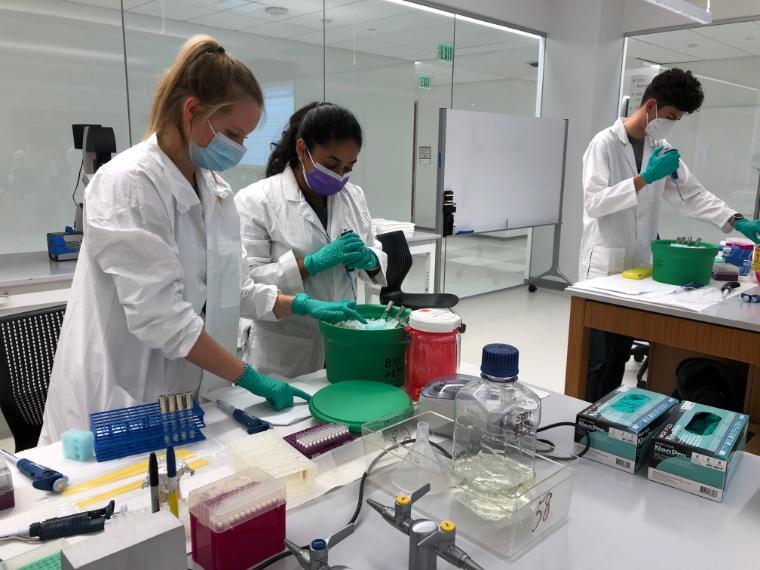Annotation
Bioengineering is also called biotechnology or biotechnology. There is no unanimously accepted definition and scope of content. It is generally believed that, as an applied science, bioengineering is a comprehensive scientific and technological system that applies the principles of biological science and engineering to serve human society through processing biology and biological processing.

Meaning
biological engineering, biotechnology, bioengineering
Research direction
In a narrow sense, it refers to the application of engineering knowledge to the field of biology Inside, a technology that uses the function of living organisms to produce substances to provide goods for human services. Bioengineering was developed in the early 1970s on the basis of molecular biology and cell biology. It includes four technical systems (or biochemical engineering, protein engineering, etc.), genetic engineering, cell engineering, enzyme engineering, and fermentation engineering. Called the six major technology systems). The above-mentioned technical systems are interdependent and complementary. They are dominated by genetic engineering, forming DNA recombination technology, cell fusion technology, cell mass culture technology, bioreactor technology, artificial modification of enzymes and proteins, and artificial synthesis technology, non-gene operation type The organism directly utilizes technology and other fields.
In a broad sense, general engineering that targets biology includes medical engineering between biology, medicine and engineering, biomedical engineering such as artificial organs and prostheses, and human engineering Science, bionics, and engineering analysis of the structure and function of organisms in these disciplines all belong to the category of bioengineering. Bioengineering is a new discipline developed on the basis of molecular biology, molecular genetics and cell biology in the early 1970s. It has played a major role in the diagnosis and treatment of energy crisis, food shortage, environmental pollution and difficult diseases faced by all mankind. People call it the "four major technologies" of the fourth industrial revolution together with energy science, information science and material science. Related research
In medicine, bioengineering can produce a large number of cheap drugs to prevent and treat human diseases, such as insulin, interferon, growth hormone, hepatitis B vaccine, etc. Bioengineering has a wide range of applications in food and light industry. In 1983, the annual output of high-fructose syrup used in beverages produced by bioengineering in the United States reached 6 million tons, thereby reducing the consumption of sucrose by half. The adoption of bioengineering technology has caused great changes in the breeding work, such as transferring disease-resistant genes into tobacco, and cultivating new tobacco varieties that prevent pests; transferring the nitrogen-fixing genes of lower biological rhizobia to the cells of higher crops In China, it has made it possible to manufacture nitrogen fertilizer by itself, and has also achieved certain results, as well as the development of mammary gland bioreactors and poultry oviduct bioreactors for genetically modified animals. Countries all over the world attach great importance to bioengineering, and our country also lists bioengineering as one of the key scientific research projects. The research of bioengineering will have a huge impact on human production methods and lifestyles.
Development
The development of systems biology science and engineering in the 21st century. In 2003, J. Keasling of Berkeley University in the United States established the world’s first Department of Synthetic Biology-Fundamentals of Systems Biology The genetic engineering of the company uses yeast cells to express natural plant medicine Qingguanin molecules, realizes engineering microbial metabolism engineering pharmacy, and develops the research and development of plant photosynthetic metabolic pathways. At the same time, many scientists and engineers of computer, microelectronics technology, nanochemistry, medical engineering transferred to the research and development of bioengineering, using computer software-aided design technology, artificial synthesis of whole genes and even genome technology, redesigning cells as computers, thus entering The era of synthetic biotechnology. China’s Zeng Bangzhe (Zeng Jie) published an article "On the Category of Systems Bioengineering" in the Chinese Academy of Sciences’ "Transgenic Animal Communications" in June 1994, declaring that the 21st century is the era of systems biological sciences and systems biological engineering. To the integration of technology, genetic engineering and cell bionic engineering were combined, and in 2002, a cell computer model (cell automatics, the bio-computer, genbrain biosystem network 2002) was proposed. System biotechnology integrates bio-nanotechnology and bio-computing technology, and begins to move towards biomedical applications of bioengineering artificially designed life systems, and will bring about the industrialization of cell pharmaceutical factories and cell biomolecular computers. In 2007, RI Kitney, Royal Academician of the United Kingdom It is said that "system biology and synthetic biology will be coupled to produce the third industrial revolution." Authoritative scientific and technological institutions in Europe and America say that the era of genetic engineering, genetically modified animals and molecular biotechnology has turned to the era of synthetic biology and systems bioengineering. In 2008 At the beginning, international and domestic systems bioengineering (systems biological engineering) research institutions have been established one after another.
